Parisian pitfalls
Though Tony Baxter and his team had crafted the most beautiful, intimate, and thoughtful version of Disneyland since Walt’s original, Disneyland Paris was doomed. Overbuilt (with an unbelievable seven hotels to serve one park) and undervalued by the French, the park was pretty quickly plunged into financial despair.
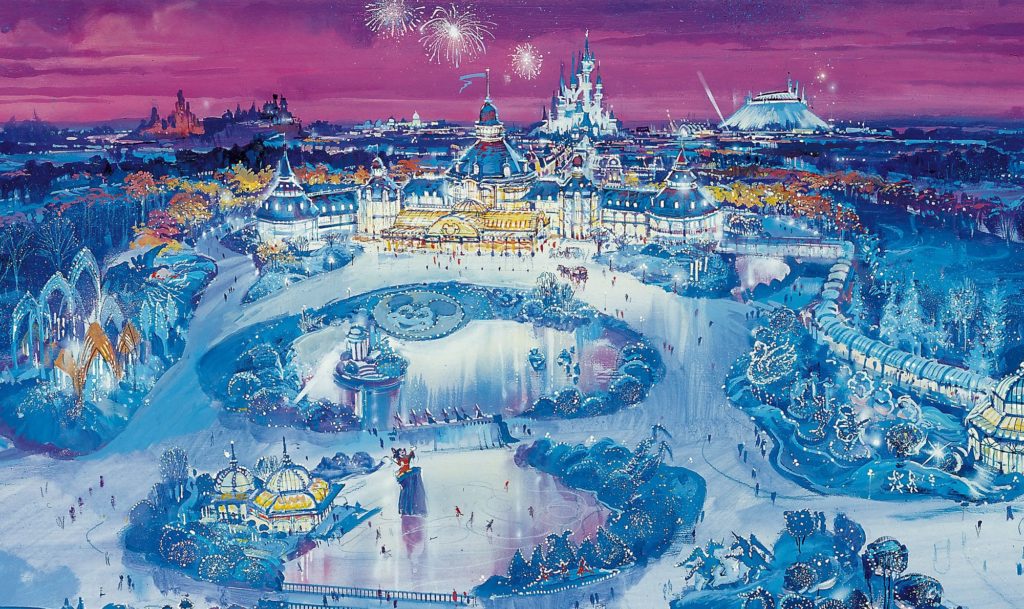
In May 1992 – the park’s second month, when interest should be at its peak – daily attendance was reportedly less than half of what Disney expected. As the resort’s first winter neared, hotel occupancy dropped so low that the company mothballed one of the resort’s hotels entirely. Creditors descended on the resort as bankruptcy was considered as a realistic plan for a strategic reorganization of debt.
The dismal situation in Paris directly lead to decades of cancellations, cop-outs, and closures across Disney Parks, with then-CEO Michael Eisner suggesting that the resort’s bankruptcy and closure was a possibility.
But Imagineers had a “Hail Mary” pass waiting in the wings. Though they’d planned to keep their secret weapon under wraps until the resort needed a revival of public interest, its debut was needed now. And unfortunately, the ambitious Discovery Mountain Imagineers had designed was now way beyond the resort’s financial capabilities. Sure, a roller coaster through the stars was a surefire way to bring guests into the Parisian park… But it could not be as grand as Discovery Mountain.
Instead, Imagineers were tasked with downsizing the peak to standard Space Mountain dimensions, featuring a single roller coaster through the stars. The Passholder-exclusive view of the ride’s onstruction ahead of its 1995 debut, though, revealed that this Space Mountain would be vastly different from any to come before…
Even if Paris’ new coaster wasn’t as groundbreaking as originally planned, it would quickly become understood as the most amazing Space Mountain on Earth… Let’s step in…
Disneyland Paris
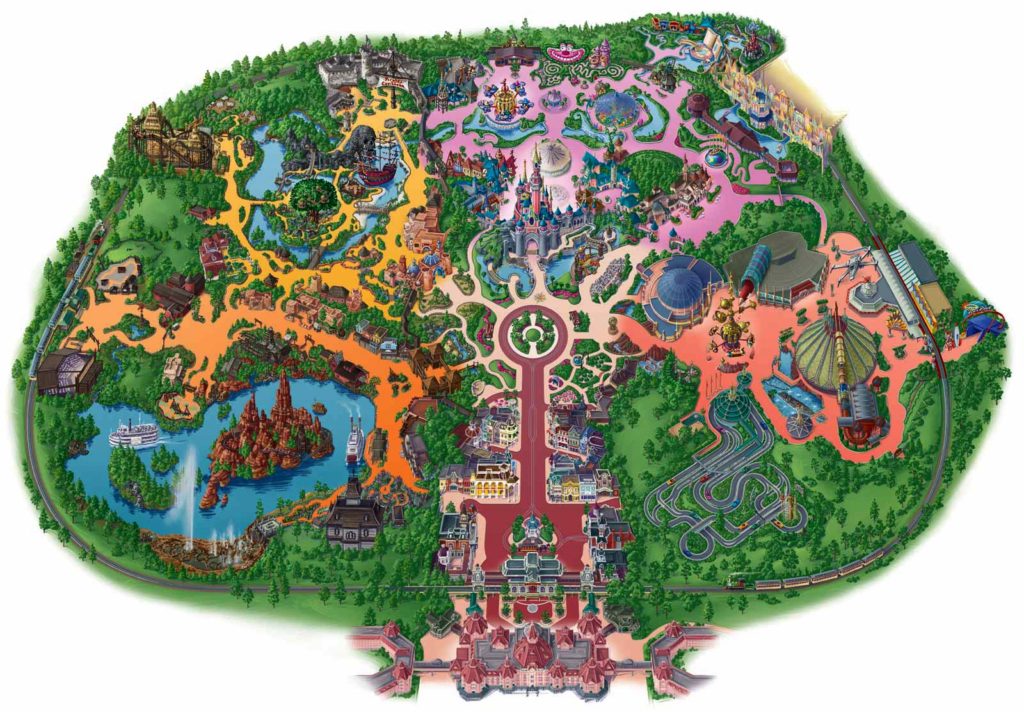
Welcome to Disneyland Paris. When this park opened in 1992, it was a beautiful, fanciful, detailed, and story-centered take on the original Disneyland in Anaheim, custom-built and meticulously-designed to appeal to European audiences. Discoveryland was just one of the major reinventions designed to make this park and its inherent Americana appeal to European audiences.
Still, it wouldn’t be until three years later that this new, literary, golden take on Tomorrowland would debut its own version of the fabled roller coasters through outer space. Space Mountain: De la Terre à la Lune opened at the center of Discoveryland on June 1, 1995.
Here, the peak is a glowing, golden mountain adorned with rivets, brass casing, and oxidized copper rails. It’s set alongside a bubbling lagoon from which iron-rich geometric rocks have burst forth as if holding up the mountain’s side. Captain Nemo’s imposing Nautilus is docked in the geothermal water.
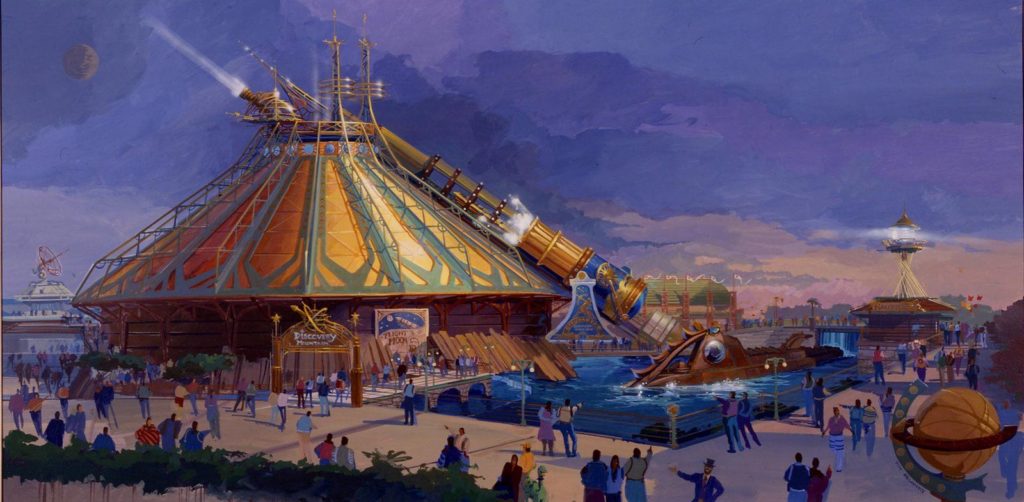
But the mountain’s most astounding feature must be the bronze Columbiad Cannon anchored at the water’s edge, scaling the entire length of the mountain’s side. It terminates in a vibrant red trajectory sight, fixed on the sky overhead.
Step under the ride’s marquee and walk along the water’s edge, around the Cannon, and prepare for adventure.
The Baltimore Gun Club Queue
As you walk along the water’s edge and pass the imposing Nautilus, you may find yourself gazing up at the towering golden façade of this one-of-a-kind Space Mountain. Within a twenty-five foot tall bronze frame is the ride’s attraction poster (perhaps the most gorgeous in the entire catalogue of Disney Parks poster art) that serves as an in-universe, Victorian-era exposition advertisement for the wonders we’re about to witness…

Suddenly, the waterfront queue gives way to a crack in the exterior of the otherwise impenetrable peak. And herein lies your first impression that this Space Mountain will be unlike any other: you’re at once standing on an open platform that passes through the core of the mountain – La Voie Stellaire.
The inner workings of the roller coaster surround you, with trains roaring through the depths of a glowing, majestic spacescape to the sounds of The Rocketeer’s orchestral soundtrack.
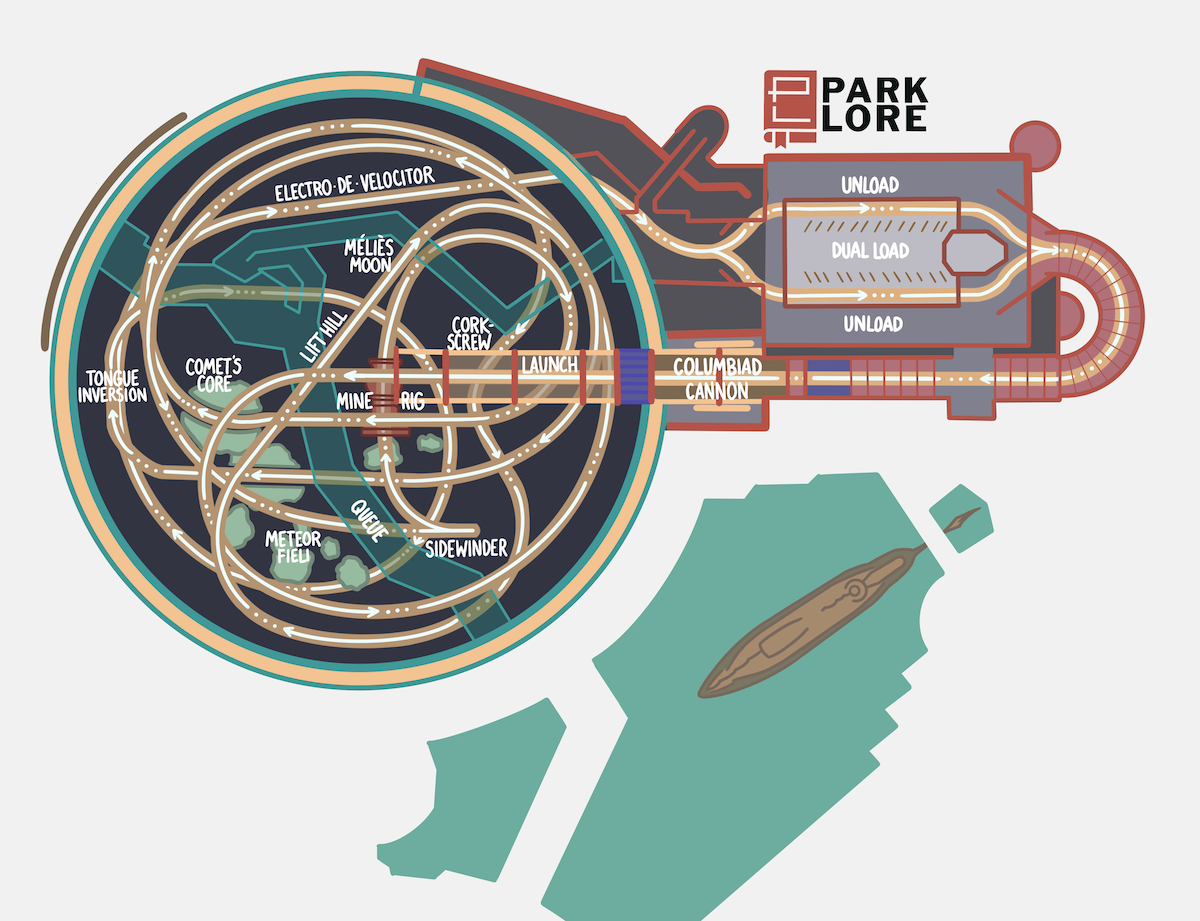
As you gaze out into the infinite unknown, a rocket train full of riders comes screaming toward the suspended pathway, diving beneath queuing guests at the last possible second. Unlike the other Space Mountain rides – populated mostly by spinning “stars” created with disco balls in the otherwise pitch-black darkness – this ride will be a sincere journey past stellar, glowing, enormous landmarks that surround you.
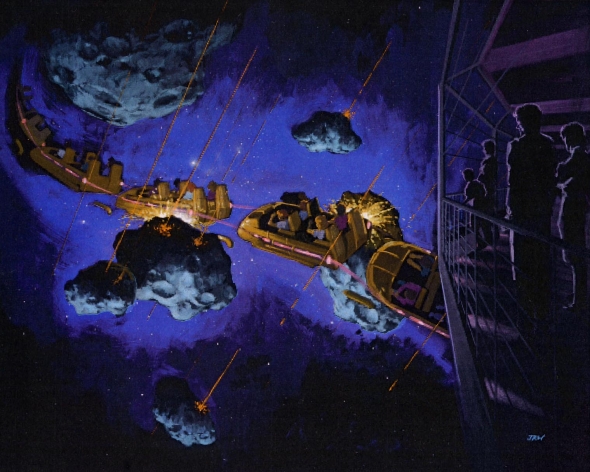
The queue continues into the Victorian Lounge of the Baltimore Gun Club, where blueprints, sketches, and schematics of the Columbiad Cannon help to explain our mission today: to board a vehicle bound for the moon, launched to the outer reaches of space.
But our journey to space begins in a most unexpected place: outside. Rather than carrying us into the depths of a claustrophobic space station like in California or Florida, our journey here begins in a new kind of loading area: a sort of open air Victorian social hall decked out with hanging banners and memorabilia from the Club. The breeze blows through as sunlight streams in.

But now, our rocket approaches: a late 1800s metal brass train… It’s time to board.
Space Mountain: De la Terre à la Lune
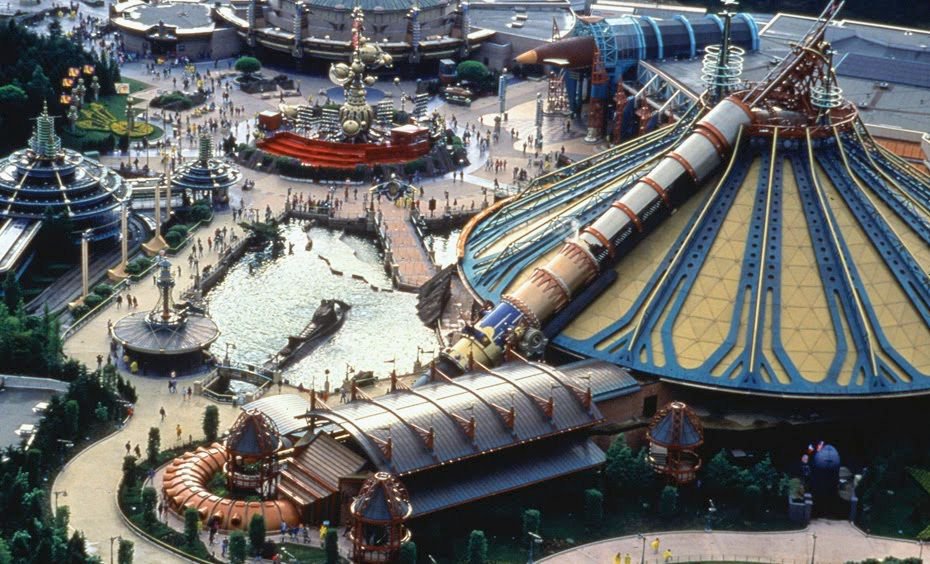

Seated on board, one of the ride’s most innovative features is immediately activated: its synchronized on-board audio track (or SOBAT) is cutting-edge, and features a score based on John Williams’ grand, cinematic film compositions. The music will accompany us through the ride, perfectly synchronized to each bend and twist in the track. It’s an adventurous, bright, orchestral score that stands as a stark contrast to the sci-fi theme that would later be developed for Disneyland in California.
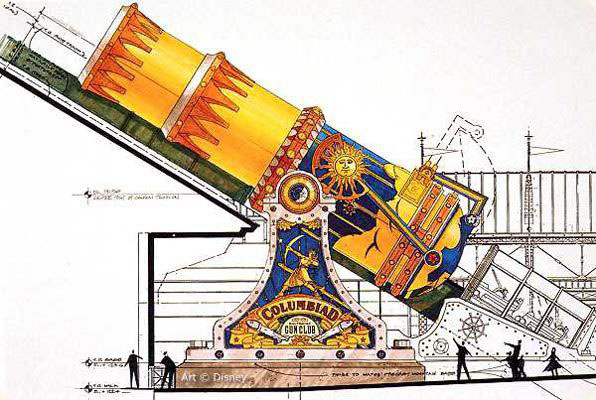
The train departs the station, and at once you find yourself in near darkness, gliding through a wide turn beneath incandescent bulbs. Then, the train dives down to the right, pulling out of the drop and aligning with a blinding sight: the length of the Columbiad Cannon.
It feels now as if the train has been hooked onto from beneath as it’s pulled dutifully up into the Cannon’s base. The Columbiad’s curved side pulls away to give onlookers a view of the loaded train. It advances higher into the cannon as pulsing lights build alongside trumpets in the score. Steam begins to spray as a great burst of fog is emitted from the Cannon’s ring. The train is hurled forward at 40 mph up the incline along the mountain’s peak, generating 1.5Gs of force!
The train is catapulted into the darkness of the mountain, immediately dropping and helixing downward between glowing blue asteroids. The rare model revealing the ride’s layout above may look like a tangled mess of swooping and diving, and it is!

Unlike the zippy Space Mountains in the U.S. and Japan, this is a thrill ride. The train dives to the ground then races upward, turning upside down through the ride’s first of three inversions.
Leveling out from the sidewinder, the train narrowly races through the metallic rings of a space mining machines (deployed by the Blue Moon Mining Company) and then races headlong toward a massive meteorite, passing perfectly through its melting, molten center and again racing downward in ever-intensifying helices.
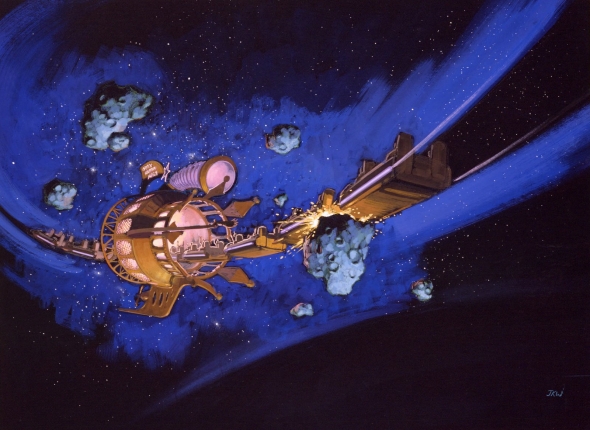
In the darkness, the train unexpectedly pulls upward and inverts through an elongated corkscrew, providing a moment of hang time and disorientation.
We round the corner and align with a lift hill concealed in the darkness. As the train is swiftly pulled to the top, an image of the Man in the Moon (from the Georges Méliès film) appears overhead, smiling and beckoning us closer!
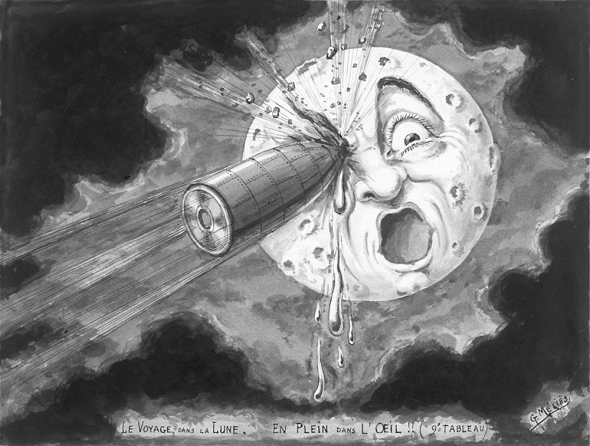
As the score’s triumphant notes tell us that we’re nearing our goal, the train dives again, swerving between massive comets, slaloming left and right and diving at the last second to avoid the queue’s path.
With a final burst, the train rears up through a unique “horseshoe” inversion (a tight, overbanked, inverting turn) as pulsing blacklights signal your re-entry into the atmosphere. Sparks rain down as the train reaches the Electro de Velocitor, roaring to a halt to signal our arrival back on Earth.
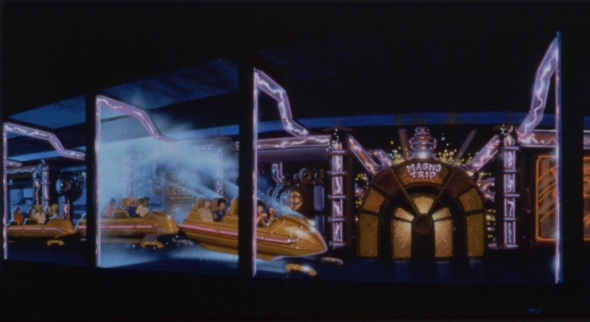
Videos of the original roller coaster were difficult to capture given the state of photography at the time, so we offer three opportunities to get an inside look: a very dark point-of-view video, a rare look at the ride’s effects and queue and this spot-on digital recreation of the ride’s layout.
But then…
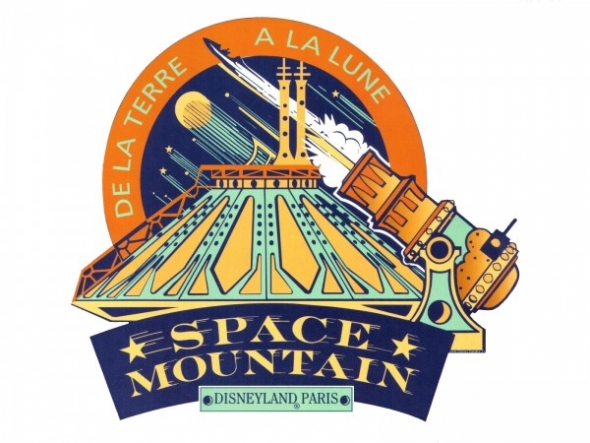
Space Mountain: De la Terre à la Lune was a true Imagineering masterpiece… an original adaptation of a timeless concept, perfectly positioned to be the headlining attraction for a uniquely wonder-ful Discoveryland and for all of Disneyland Paris. And today, it’s gone.
On the last page, we’ll address what happened to put an end to this interstellar fantasy journey and why it may signal the end of an era at Imagineering.



